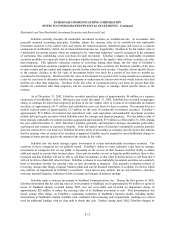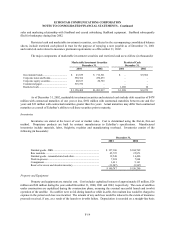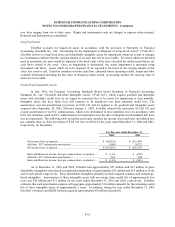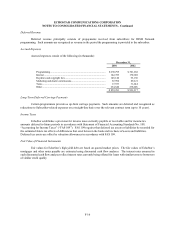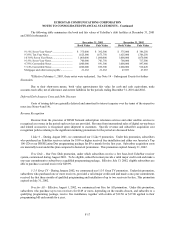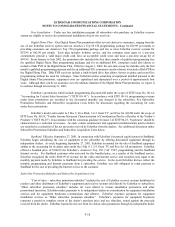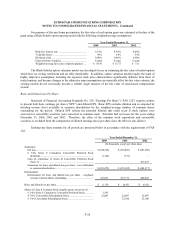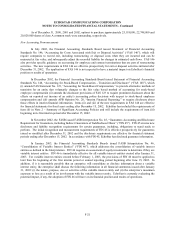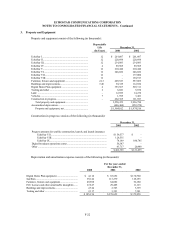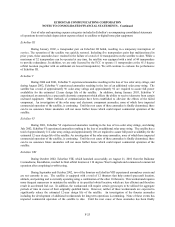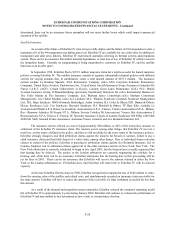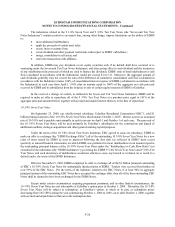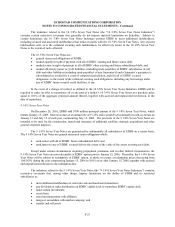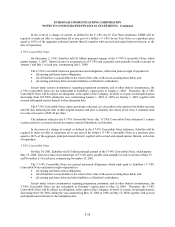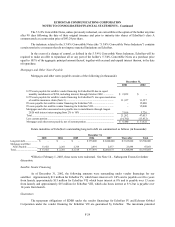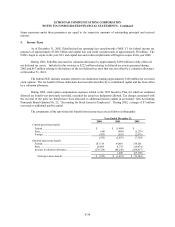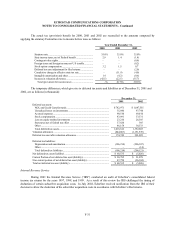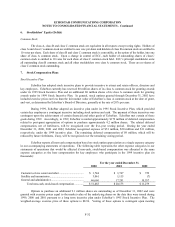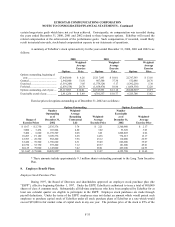Dish Network 2002 Annual Report Download - page 83
Download and view the complete annual report
Please find page 83 of the 2002 Dish Network annual report below. You can navigate through the pages in the report by either clicking on the pages listed below, or by using the keyword search tool below to find specific information within the annual report.ECHOSTAR COMMUNICATIONS CORPORATION
NOTES TO CONSOLIDATED FINANCIAL STATEMENTS - Continued
F-23
Cost of sales and operating expense categories included in EchoStar’s accompanying consolidated statements
of operations do not include depreciation expense related to satellites or digital home plan equipment.
EchoStar III
During January 2002, a transponder pair on EchoStar III failed, resulting in a temporary interruption of
service. The operation of the satellite was quickly restored. Including five transponders pairs that malfunctioned in
prior years, these anomalies have resulted in the failure of a total of 12 transponders on the satellite to date. While a
maximum of 32 transponders can be operated at any time, the satellite was equipped with a total of 44 transponders
to provide redundancy. In addition, we are only licensed by the FCC to operate 11 transponders at the 61.5 degree
orbital location (together with an additional six leased transponders). We will continue to evaluate the performance
of EchoStar III.
EchoStar V
During 2000 and 2001, EchoStar V experienced anomalies resulting in the loss of two solar array strings, and
during August 2002, EchoStar V experienced anomalies resulting in the loss of an additional solar array string. The
satellite has a total of approximately 96 solar array strings and approximately 92 are required to assure full power
availability for the estimated 12-year design life of the satellite. In addition, during January 2003, EchoStar V
experienced an anomaly in a spacecraft electronic component which affects the ability to receive telemetry from certain
on-board equipment. Other methods of communication have been established to alleviate the effects of the failed
component. An investigation of the solar array and electronic component anomalies, none of which have impacted
commercial operation of the satellite, is continuing. Until the root cause of these anomalies is finally determined, there
can be no assurance future anomalies will not cause further losses which could impact commercial operation of the
satellite.
EchoStar VI
During 2001, EchoStar VI experienced anomalies resulting in the loss of two solar array strings, and during
July 2002, EchoStar VI experienced anomalies resulting in the loss of an additional solar array string. The satellite has a
total of approximately 112 solar array strings and approximately 106 are required to assure full power availability for the
estimated 12-year design life of the satellite. An investigation of the solar array anomalies, none of which have impacted
commercial operation of the satellite, is continuing. Until the root cause of these anomalies is finally determined, there
can be no assurance future anomalies will not cause further losses which could impact commercial operation of the
satellite.
EchoStar VIII
During October 2002, EchoStar VIII, which launched successfully on August 21, 2002 from the Baikonur
Cosmodrome, Kazakhstan, reached its final orbital location at 110 degrees West Longitude and commenced commercial
operation after completing in-orbit testing.
During September and October 2002, two of the thrusters on EchoStar VIII experienced anomalous events and
are not currently in use. The satellite is equipped with a total of 12 thrusters that help control spacecraft location,
attitude, and pointing and is currently operating using a combination of the other 10 thrusters. This workaround requires
more frequent maneuvers to maintain the satellite at its specified orbital location, which are less efficient and therefore
result in accelerated fuel use. In addition, the workaround will require certain gyroscopes to be utilized for aggregate
periods of time in excess of their originally qualified limits. However, neither of these workarounds are expected to
significantly reduce the estimated 12-year design life of the satellite. An investigation of the thruster anomalies
including the development of additional workarounds for long term operations is continuing. None of these events has
impacted commercial operation of the satellite to date. Until the root cause of these anomalies has been finally


